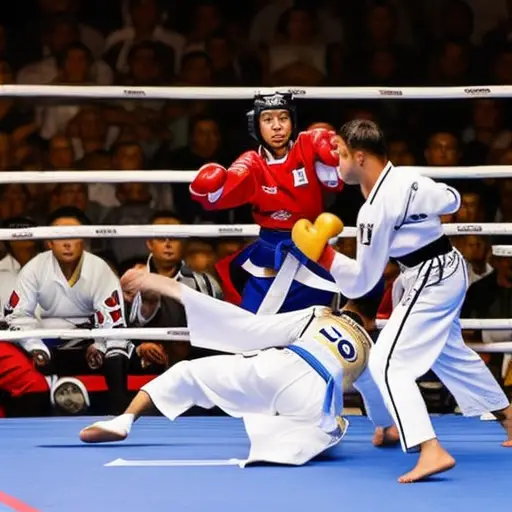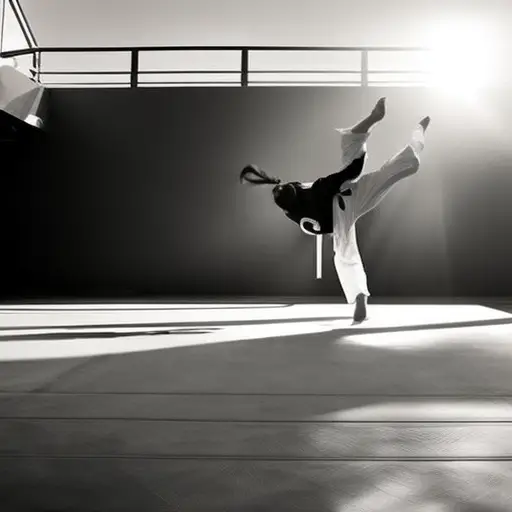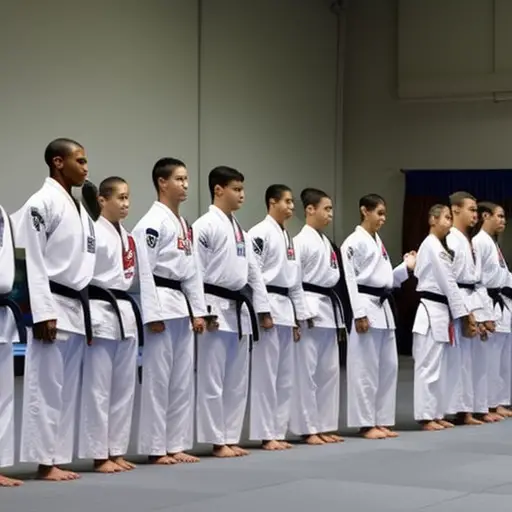The Connection Between Taekwondo and Meditation

In the realm of physical discipline and mental tranquility, the seemingly contrasting practices of taekwondo and meditation find an unexpected harmony. This article explores the profound connection between these two disciplines, illuminating the shared principles and benefits they offer.
Delving into the ways in which meditation enhances taekwondo practice and vice versa, we uncover the holistic approach that unifies these ancient practices.
Prepare to embark on a journey of self-discovery, unlocking the potential for growth and inner peace through the fusion of taekwondo and meditation.
The Origins of Taekwondo and Meditation
The origins of Taekwondo and meditation can be traced back to ancient Eastern philosophies and practices. Taekwondo, a Korean martial art, has its roots in the ancient Korean martial arts known as Subak and Taekkyeon. These martial arts were developed as a means of self-defense, but also as a way to cultivate discipline, focus, and spiritual growth. Over time, Taekwondo evolved into a systematic martial art with its own unique techniques and training methods.
Meditation, on the other hand, has been practiced for thousands of years in various Eastern cultures, including those of India, China, and Japan. It is a practice that involves training the mind to achieve a state of deep relaxation and heightened awareness. Meditation has long been associated with spiritual and mental well-being, as well as the development of inner peace and tranquility.
The cultural significance of Taekwondo and meditation cannot be overstated. Both practices are deeply rooted in the traditions and values of Eastern cultures. Taekwondo, in particular, is considered a national sport in South Korea and has been embraced by people all over the world as a way to promote physical fitness, self-confidence, and discipline. Similarly, meditation is an integral part of many Eastern philosophies and religions, such as Buddhism and Hinduism, and is seen as a means to achieve enlightenment and self-realization.
The Shared Principles of Taekwondo and Meditation
While Taekwondo and meditation are distinct practices, they share common principles that contribute to personal growth and well-being. Both Taekwondo and meditation emphasize the importance of discipline, focus, and self-awareness. These shared principles are what make them complementary practices that can be incorporated into one’s daily routine.
Some of the shared principles between Taekwondo and meditation include:
-
Discipline: Both Taekwondo and meditation require discipline in order to fully reap their benefits. Taekwondo practitioners must adhere to a strict training regimen, while meditators must commit to regular practice. This discipline helps individuals develop self-control and consistency in their actions.
-
Focus: Taekwondo and meditation both require a deep level of focus. In Taekwondo, practitioners must concentrate on their movements and techniques, while in meditation, individuals focus their attention on their breath or a specific object. This ability to focus enhances concentration and helps individuals stay present in the moment.
Incorporating techniques from both Taekwondo and meditation allows individuals to cultivate physical and mental well-being. Taekwondo provides a physical outlet for stress and helps develop strength and flexibility, while meditation promotes relaxation and mental clarity. By embracing the shared principles of discipline and focus, individuals can experience personal growth and improve their overall well-being.
The Physical and Mental Benefits of Taekwondo and Meditation
The practice of Taekwondo and meditation offers a range of physical and mental benefits. One of the key benefits is the strengthening of the mind-body connection, as practitioners learn to synchronize their movements with their thoughts and emotions.
Additionally, Taekwondo and meditation promote improved focus and mindfulness, allowing individuals to be fully present in the moment.
Lastly, the combination of physical activity and mindfulness techniques can help reduce stress and anxiety, providing practitioners with a sense of calm and balance in their daily lives.
Mind-Body Connection Strengthened
Practitioners of taekwondo and meditation can experience a profound strengthening of their mind-body connection, leading to numerous physical and mental benefits. The practice of taekwondo requires focused concentration and disciplined control of the body, which in turn enhances concentration and self-awareness. Meditation, on the other hand, trains the mind to be present and aware of the body’s sensations and movements. This combination of physical discipline and mental focus cultivates a deep connection between the mind and body.
The physical and mental benefits of this strengthened mind-body connection are vast.
- Strengthened concentration: Taekwondo and meditation practices both require concentration and focus, leading to improved attention and the ability to stay present in the moment.
- Improved self-awareness: Through the practice of taekwondo and meditation, individuals become more attuned to their own thoughts, emotions, and physical sensations, leading to a greater understanding of oneself and improved self-awareness.
Improved Focus and Mindfulness
One of the key benefits of combining taekwondo and meditation is the heightened focus and mindfulness that practitioners can experience. Through the practice of taekwondo, individuals learn to concentrate on their movements, techniques, and breathing. This improved concentration carries over into their daily lives, allowing them to stay focused on tasks and goals.
Additionally, meditation helps to cultivate a state of mental clarity, enabling practitioners to let go of distractions and negative thoughts. By incorporating meditation into their taekwondo practice, individuals can develop a deeper sense of mindfulness, which involves being fully present in the moment.
This heightened focus and mindfulness not only enhance performance in taekwondo but also benefit other areas of life, such as work, relationships, and personal development.
Reduced Stress and Anxiety
Furthermore, in addition to improved focus and mindfulness, practitioners of taekwondo and meditation can also experience the physical and mental benefits of reduced stress and anxiety. The practice of taekwondo involves intense physical activity, which releases endorphins, the body’s natural stress-relieving hormones. This physical exertion helps to alleviate tension and anxiety, leaving practitioners feeling more relaxed and at ease.
Additionally, meditation, a key component of taekwondo training, has been proven to have a positive impact on mental health. By focusing on the present moment and quieting the mind, meditation can reduce stress levels and promote a sense of calm and tranquility.
Overall, the combination of taekwondo and meditation provides a holistic approach to reducing stress and improving mental wellbeing.
-
Physical Benefits:
-
Releases endorphins, the body’s natural stress-relieving hormones
-
Alleviates tension and anxiety
-
Mental Benefits:
-
Reduces stress levels and promotes a sense of calm and tranquility
-
Improves overall mental wellbeing.
Techniques for Incorporating Meditation Into Taekwondo Practice
Incorporating meditation into Taekwondo practice can enhance the overall experience and benefits of the martial art.
Meditation offers numerous benefits, such as reducing stress, improving focus and concentration, and promoting a sense of calm and clarity.
Benefits of Meditation
To enhance their taekwondo practice, practitioners can actively incorporate meditation techniques into their training sessions. Meditation has been practiced for centuries and has its origins in ancient Eastern traditions such as Buddhism and Hinduism. There are various types of meditation techniques that can be beneficial for taekwondo practitioners, including:
- Mindfulness meditation: This technique involves focusing on the present moment and cultivating awareness of one’s thoughts and feelings.
- Loving-kindness meditation: This technique involves generating feelings of compassion and love towards oneself and others.
By incorporating these meditation techniques into their taekwondo practice, practitioners can experience several benefits. Meditation can help improve focus, concentration, and mental clarity, which are essential for performing precise techniques and movements in taekwondo. Additionally, it can enhance mental resilience, reduce stress and anxiety, and promote overall well-being.
These benefits contribute to the development of the mind-body connection in taekwondo practice, which will be discussed further in the subsequent section.
Mind-Body Connection
One effective way to cultivate the mind-body connection in taekwondo practice is by incorporating meditation techniques. Mindfulness techniques and mind-body exercises can greatly enhance the overall experience and benefits of taekwondo training.
By integrating meditation into taekwondo practice, practitioners can develop a greater awareness of their physical movements, mental state, and emotions. This heightened sense of awareness allows individuals to better understand and control their bodies, leading to improved technique, balance, and coordination.
Additionally, meditation helps to calm the mind, reduce stress, and improve concentration, all of which are essential for effective taekwondo practice. Mind-body exercises, such as deep breathing and visualization, can also be integrated to further enhance the mind-body connection.
Effective Meditation Techniques
By practicing focused breathing and visualization exercises, taekwondo practitioners can effectively incorporate meditation into their training routine. Meditation is a powerful tool that can enhance the mind-body connection and improve overall performance in taekwondo.
Here are some effective meditation techniques that can be incorporated into taekwondo practice:
-
Mindful breathing: By focusing on the breath, practitioners can bring their attention to the present moment and cultivate a sense of calmness and focus.
-
Visualization: Visualizing successful techniques and movements can help improve muscle memory and enhance performance during training and competitions.
These techniques not only promote relaxation and mental clarity but also help in developing mindfulness and focus, which are essential in taekwondo training. By incorporating meditation into their practice, taekwondo practitioners can achieve a greater sense of self-awareness and unlock their full potential in the martial art.
Now, let’s explore the importance of mindfulness and focus in taekwondo training.
Mindfulness and Focus in Taekwondo Training
How can mindfulness and focus be developed in Taekwondo training?
Taekwondo, a martial art that originated in Korea, not only focuses on physical techniques but also emphasizes the importance of mental discipline. Mindfulness techniques and concentration exercises play a crucial role in developing focus and awareness during training.
One way to cultivate mindfulness in Taekwondo is through the practice of meditation. This involves finding a quiet space, sitting comfortably, and focusing on the breath or a specific point of focus. By regularly engaging in meditation, practitioners learn to quiet their minds, stay present, and enhance their ability to concentrate.
In addition to meditation, concentration exercises are incorporated into Taekwondo training to improve focus. These exercises can include drills that require practitioners to maintain attention on a specific target or task, such as hitting a target with precision or performing intricate movements with accuracy. By repeatedly practicing these exercises, practitioners develop the ability to block out distractions and maintain a heightened state of awareness.
Furthermore, mindfulness can be cultivated through the practice of forms or patterns in Taekwondo. Forms are a series of predetermined movements that practitioners perform in a specific sequence. By focusing on each movement and being fully present in the moment, practitioners develop concentration, body awareness, and mindfulness.
How Taekwondo Enhances Meditation Practice
Taekwondo practitioners can enhance their meditation practice through the integration of martial arts techniques and principles. By incorporating Taekwondo into their meditation routine, practitioners can experience improved concentration and mental clarity. Here are two ways in which Taekwondo enhances meditation practice:
-
Physical Awareness: Taekwondo involves precise movements and control of the body. Practicing martial arts techniques such as kicks, punches, and blocks requires a deep level of physical awareness. This heightened body awareness can be carried over to meditation, allowing practitioners to better focus on their breath, posture, and sensations within the body. By cultivating physical awareness through Taekwondo, meditators can develop a stronger connection between their mind and body during their meditation practice.
-
Discipline and Mental Strength: Taekwondo training emphasizes discipline and mental strength. In order to master the techniques and progress in the martial art, practitioners must develop a strong sense of focus and determination. These qualities can greatly benefit meditation practice, as they allow individuals to better navigate distractions and maintain a clear and focused mind. The discipline cultivated through Taekwondo can also help practitioners establish a consistent meditation routine, ensuring regular practice and progress in their mindfulness journey.
The Holistic Approach: Balancing Taekwondo and Meditation
Achieving a harmonious balance between the physical and mental aspects of one’s practice is essential in successfully integrating Taekwondo and meditation. Balancing techniques and integrating mindfulness are key components of this holistic approach. By combining the physical discipline of Taekwondo with the mental focus of meditation, practitioners can experience a deeper connection between mind and body.
To illustrate the importance of balance in this integration, let’s take a look at the following table:
| Physical Aspect of Taekwondo | Mental Aspect of Meditation | Balancing Technique |
|---|---|---|
| Kicks and Strikes | Mindfulness | Breathing exercises |
| Forms | Concentration | Visualization |
| Sparring | Self-awareness | Body scanning |
| Strength Training | Relaxation | Progressive muscle relaxation |
This table demonstrates how each physical aspect of Taekwondo can be balanced with a corresponding mental aspect of meditation. For example, kicks and strikes require focus and precision, which can be enhanced through mindfulness and breathing exercises. Similarly, forms can be performed with concentration and visualization techniques.
Frequently Asked Questions
What Are the Different Styles of Taekwondo and How Do They Incorporate Meditation?
Different styles of taekwondo include ITF, WTF, and ATA. Each style incorporates meditation in various ways, such as through breathing exercises, mindfulness techniques, and mental focus. These practices offer numerous benefits for athletes, including improved concentration, mental clarity, and stress reduction.
Can Meditation Be Practiced Without Engaging in Physical Taekwondo Techniques?
Meditation techniques can be practiced without engaging in physical taekwondo techniques. The benefits of meditation, such as increased mindfulness, stress reduction, and improved mental clarity, can be experienced independently from the physical aspects of taekwondo.
How Does Taekwondo and Meditation Help in Improving Self-Discipline and Self-Control?
Taekwondo and meditation can improve self-discipline and self-control by promoting mental focus and emotional well-being. The practice of taekwondo encourages concentration, while meditation helps to reduce stress and increase mindfulness, leading to improved self-regulation and emotional stability.
Are There Any Specific Breathing Techniques Used in Taekwondo Meditation?
Breathing techniques in taekwondo meditation play a crucial role in promoting focus, relaxation, and mindfulness. By incorporating specific breathing patterns, practitioners can enhance their physical and mental performance, leading to improved self-discipline and self-control.
Can Taekwondo and Meditation Be Beneficial for Individuals With Anxiety or Stress-Related Issues?
Incorporating taekwondo and meditation can be highly beneficial for individuals with anxiety or stress-related issues. This holistic approach offers a range of benefits such as improved mental focus, emotional regulation, and overall well-being, making it an effective tool for managing these conditions.
Conclusion
In conclusion, the practice of taekwondo and meditation share a deep connection that transcends their individual origins. Both disciplines emphasize the importance of physical and mental balance, promoting mindfulness, focus, and self-discipline.
By incorporating meditation into taekwondo training, practitioners can enhance their overall experience and cultivate a holistic approach to their practice. Like the intertwining branches of a sturdy tree, taekwondo and meditation support and strengthen each other, creating a harmonious and fulfilling journey towards self-improvement.





